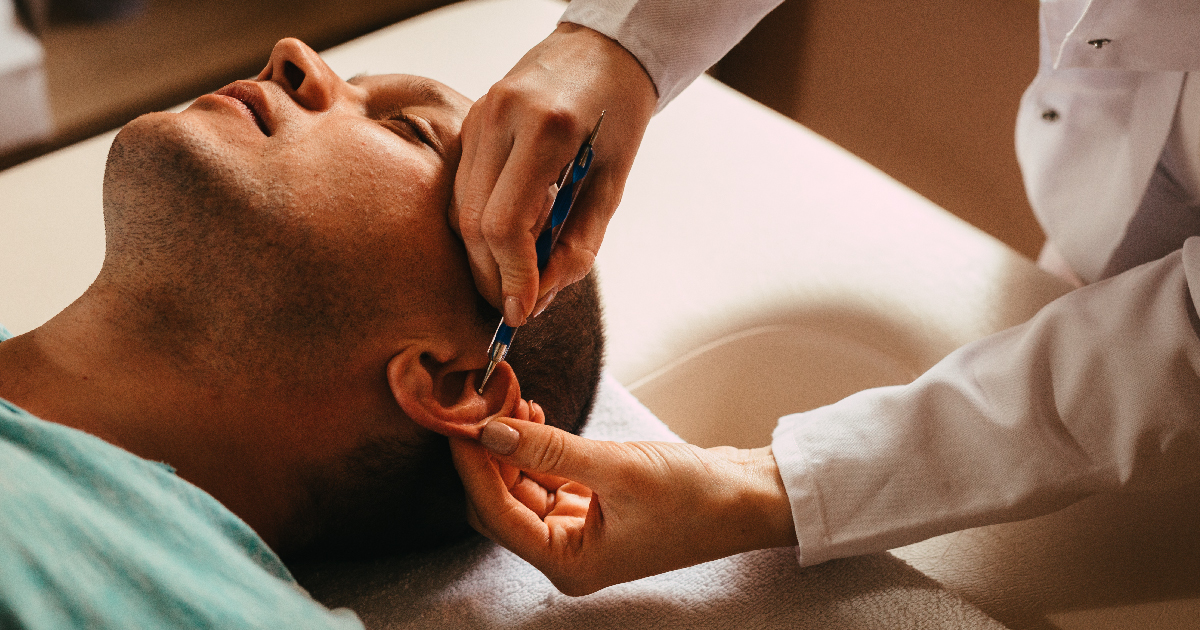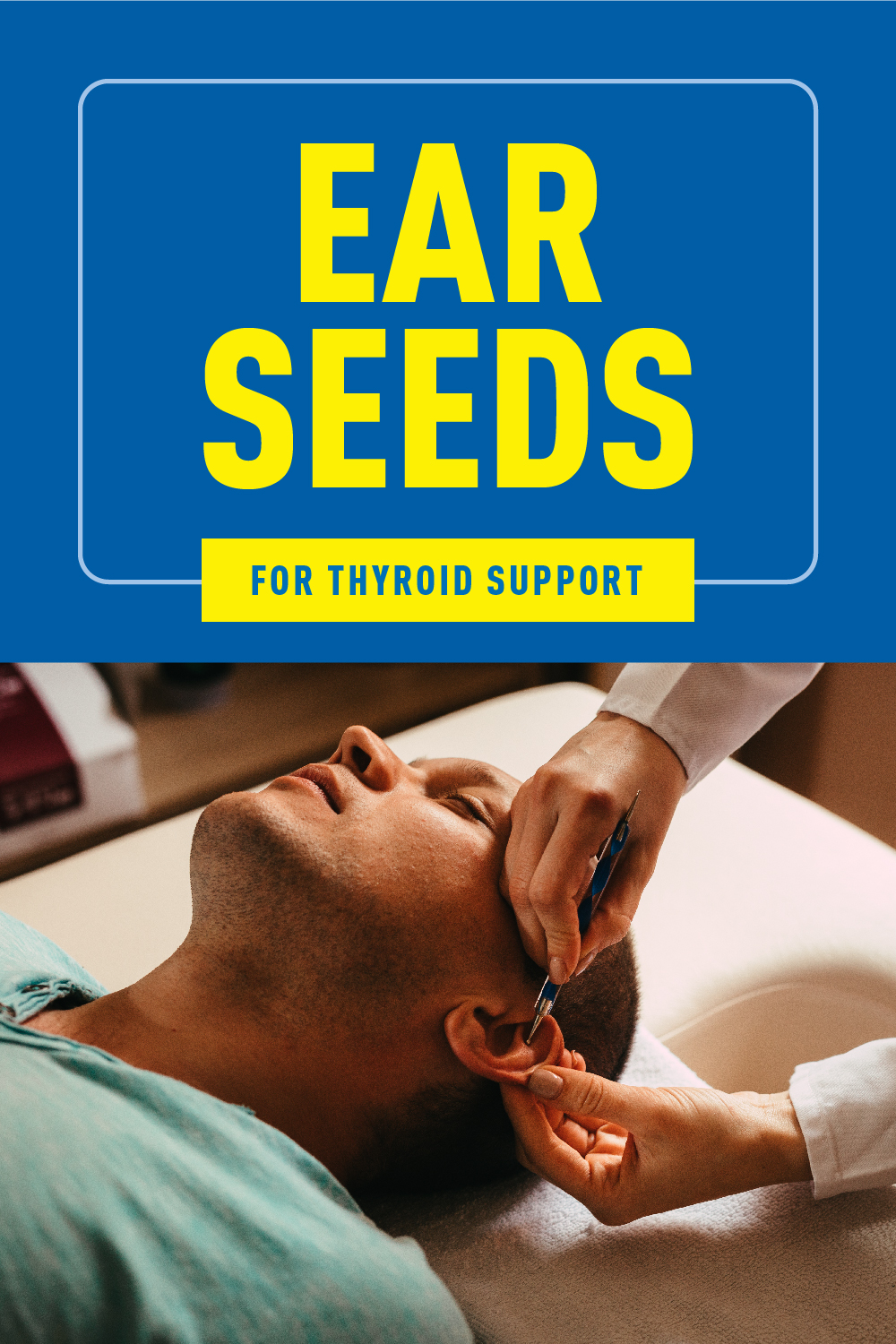Expert Advice

Acella Pharmaceuticals, LLC, is partnering with Ericca Burke, a board-certified licensed acupuncturist, to bring greater awareness to the importance of thyroid care and education. This post was sponsored by Acella Pharmaceuticals and should not be construed as medical advice. Please talk to your doctor about your individual medical situation.
Disclaimer: The information provided is for educational purposes only and does not substitute professional medical advice. Consult a medical professional or healthcare provider before beginning any exercise, fitness, diet, or nutrition routine.
Ear seeds are a form of auriculotherapy. They stimulate pressure points on the ear and may impact thyroid health. Through different ear seed techniques a patient may see differences in their thyroid function and wellness from ear seeds.
What are Ear Seeds?
Ear seeds are tiny spheres applied to acupuncture points in the ear with adhesive tape. They are a form of auriculotherapy. This is is the practice of stimulating acupuncture points on the ear. Check out my recent post on auriculotherapy to learn more.
Ear seeds got their name because the small sphere is often an actual seed from the vaccaria plant. Today, some types of ear seeds use gold-plated or stainless-steel balls instead of vaccaria seeds.
How Ear Seeds May Impact Thyroid Health
The ear contains a microsystem of the body, which means that various parts of the body have been mapped to corresponding locations on the ear. Nerve endings from the brain connect to the ear and can send signals to the various body parts that are stimulated through the ear. The thyroid is just one of the many body parts that can be located on the ear. Applying ear seeds to the thyroid and related areas on the ear can send a message to the brain to balance and heal the thyroid. Again my post, Auriculotherapy for Thyroid Support, is a great resource to learn more about the specific locations of these points.
How to Get Started with a Practitioner
If you’re interested in trying out ear seeds, you have several options. You can start by finding a practitioner who is experienced with ear seeds. The advantage of this approach is that you will have a professional who knows exactly how and where to place the ear seeds appropriate for you. If the practitioner is an acupuncturist, they will also be able to craft a treatment from a Chinese medicine perspective that is specific to you and your condition.
You can find a certified acupuncturist on the National Certification Commission for Acupuncture and Oriental Medicine (NCCAOM) website in their practitioner directory here: https://www.nccaom.org/find-a-practitioner-directory.
Please note that not all acupuncturists work with ear seeds. Be sure to ask about ear seeds before scheduling an appointment. Bodyworkers, such as massage therapists, also can be trained to apply ear seeds. If you choose to work with a bodyworker, it is recommended that you confirm they are a certified ear seeds practitioner.
How to Get Started on Your Own
If you’re looking for a low-cost option, you might choose to buy ear seeds in a pack or kit and apply them yourself at home. It is recommended that you purchase ear seeds from an acupuncturist or a provider who is certified to use ear seeds. That way, you will know that you are getting a quality product that is appropriate for use on the ear. The provider may also be able to give you personalized guidance on how to use ear seeds. Ear seeds are sold in packs or kits. Kits will often include directions with pictures and tweezers in addition to the ear seeds. A kit is a great option for a beginner.
Another consideration is the type of ear seed. Traditional vaccaria seeds are usually the most cost-effective and easy choice. Gold-plated metal seeds have a tonifying effect and should only be used when it is appropriate to tonify that area of the ear. Silver-plated ear seeds have a sedating effect and should only be used if sedation is appropriate. Stainless steel ears seeds have a neutral effect, which is neither tonifying nor sedating. In the case of hypothyroidism, it would not be appropriate to sedate the thyroid from a Chinese medicine perspective, and silver-plated ear seeds are not recommended.
If you have a latex allergy, it is important to look for latex-free ear seeds, which usually employ surgical tape as the adhesive rather than a Band-Aid type backing. Keep in mind that ear seeds are for external use only. Ear seeds should be kept out of reach of children and pets. Generally, ear seeds are not recommended for pregnant women, and pregnant women should consult an acupuncturist before use.
How to Use Ear Seeds
If you are going to apply ear seeds at home, start by washing your hands. If you have an alcohol swab, use the swab to clean your ear. You can also put some isopropyl alcohol on a cotton ball and use that to clean your ear. Wait for the alcohol to dry. Use a pair of tweezers to peel off an ear seed from the pack. Look into a mirror to identify the location on your ear that corresponds to the point you want to seed. Place the ear seed on the chosen point and use the handle of the tweezer or your fingers to press the ear seed in place. Be sure to gently press down on all sides to hold the ear seed in place.
After your ear seeds are in, you can leave them alone or stimulate them with gentle pressure every several hours or once or twice a day, depending on your preference. Know that the ear seeds are working just by being on your ears. The sphere will gently apply acupressure to the acupuncture point you've chosen by being attached to your ear with the adhesive tape. Ear seeds can remain in place for up to five days. It is OK to shower with ear seeds in. After removing ear seeds, wait at least eight hours to allow the skin to rest before reapplying new seeds.
What to Expect from Ear Seeds
Usually, people report feeling a sense of calm when they wear ear seeds. The goal is for whatever condition that is being treated to begin to improve. The timing is different for every person. Sometimes, an achy discomfort may be experienced. This can be an indication that the seeds are activating the acupuncture points. For side sleepers, ear seeds may be uncomfortable during sleep. An option, in this case, is to wear ear seeds during the day, remove them at night before bed, and apply a new set in the morning.
If ear seeds were placed by a provider, please let the provider know if you experience any discomfort so they can advise you appropriately. If you experience any redness or itching, it is recommended that you remove the ear seeds immediately. Please consult a medical professional if you have any concerns.

1754-v1
Note that DTE products, including NP Thyroid®, have not been reviewed by the FDA for safety or efficacy.
IMPORTANT RISK INFORMATION, INCLUDING BOXED WARNING & INDICATIONS
Important Risk Information
Drugs with thyroid hormone activity, alone or together with other therapeutic agents, have been used for the treatment of obesity. In euthyroid patients, doses within the range of daily hormonal requirements are ineffective for weight reduction. Larger doses may produce serious or even life-threatening manifestations of toxicity, particularly when given in association with sympathomimetic amines such as those used for their anorectic effects.
- NP Thyroid® is contraindicated in patients with uncorrected adrenal insufficiency, untreated thyrotoxicosis, and hypersensitivity to any component of the product.
- In the elderly and in patients with cardiovascular disease, NP Thyroid® should be used with greater caution than younger patients or those without cardiovascular disease.
- Use of NP Thyroid® in patients with diabetes mellitus or adrenal cortical insufficiency may worsen the intensity of their symptoms.
- The therapy of myxedema coma requires simultaneous administration of glucocorticoids.
- Concomitant use of NP Thyroid® with oral anticoagulants alters the sensitivity of oral anticoagulants. Prothrombin time should be closely monitored in thyroid-treated patients on oral anticoagulants.
- In infants, excessive doses of NP Thyroid® may produce craniosynostosis.
- Partial loss of hair may be experienced by children in the first few months of therapy but is usually transient.
- Adverse reactions associated with NP Thyroid® therapy are primarily those of hyperthyroidism due to therapeutic overdosage.
- Many drugs and some laboratory tests may alter the therapeutic response to NP Thyroid ®. In addition, thyroid hormones and thyroid status have varied effects on the pharmacokinetics and actions of other drugs. Administer at least 4 hours before or after drugs that are known to interfere with absorption. Evaluate the need for dose adjustments when regularly administering within one hour of certain foods that may affect absorption.
- NP Thyroid® should not be discontinued during pregnancy, and hypothyroidism diagnosed during pregnancy should be promptly treated.
Indications
NP Thyroid® (thyroid tablets, USP) is a prescription medicine that is used to treat a condition called hypothyroidism from any cause, except for cases of temporary hypothyroidism, which is usually associated with an inflammation of the thyroid (thyroiditis). It is meant to replace or supplement a hormone that is usually made by your thyroid gland.
NP Thyroid® is also used in the treatment and prevention of normal functioning thyroid goiters, such as thyroid nodules, Hashimoto’s thyroiditis, multinodular goiter, and in the management of thyroid cancer.
Revised
10/2023
You Are About To Leave This Website
By clicking continue, this link will take you to a website to which Alora Pharmaceuticals’ Policies & Terms of Use do not apply.
^Based on prescriptions filled, NP Thyroid® is the #1 Prescribed DTE in the United States. Source: IQVIA National Prescription Audit (NPA) data on file. Acella Pharmaceuticals, LLC.
